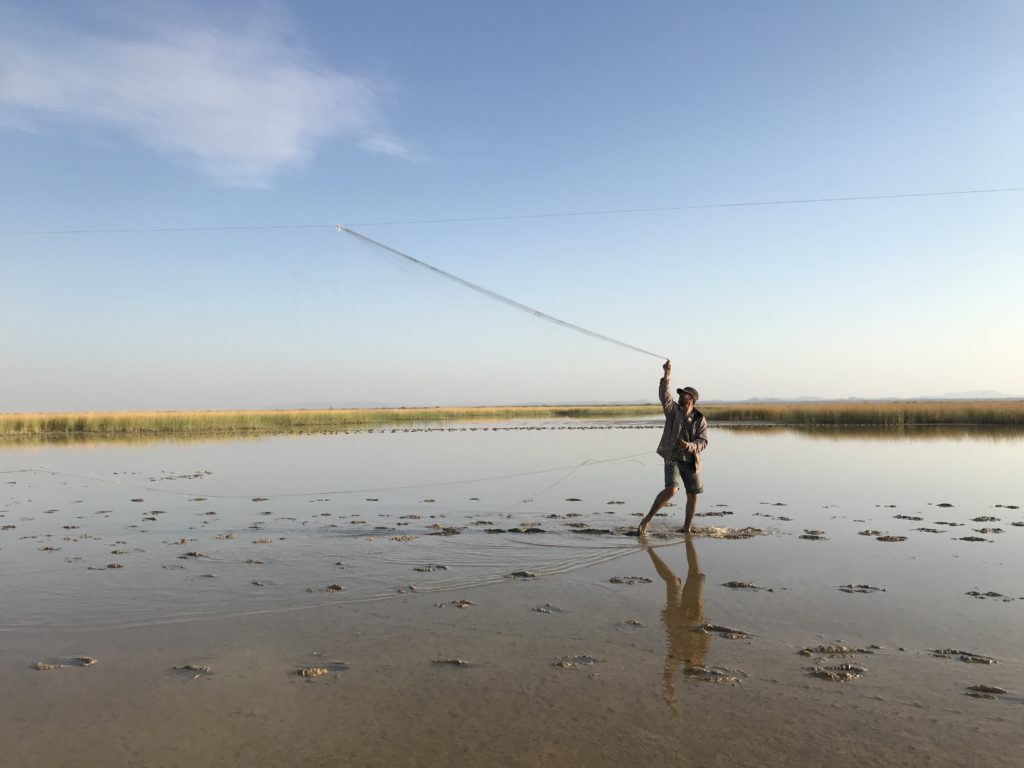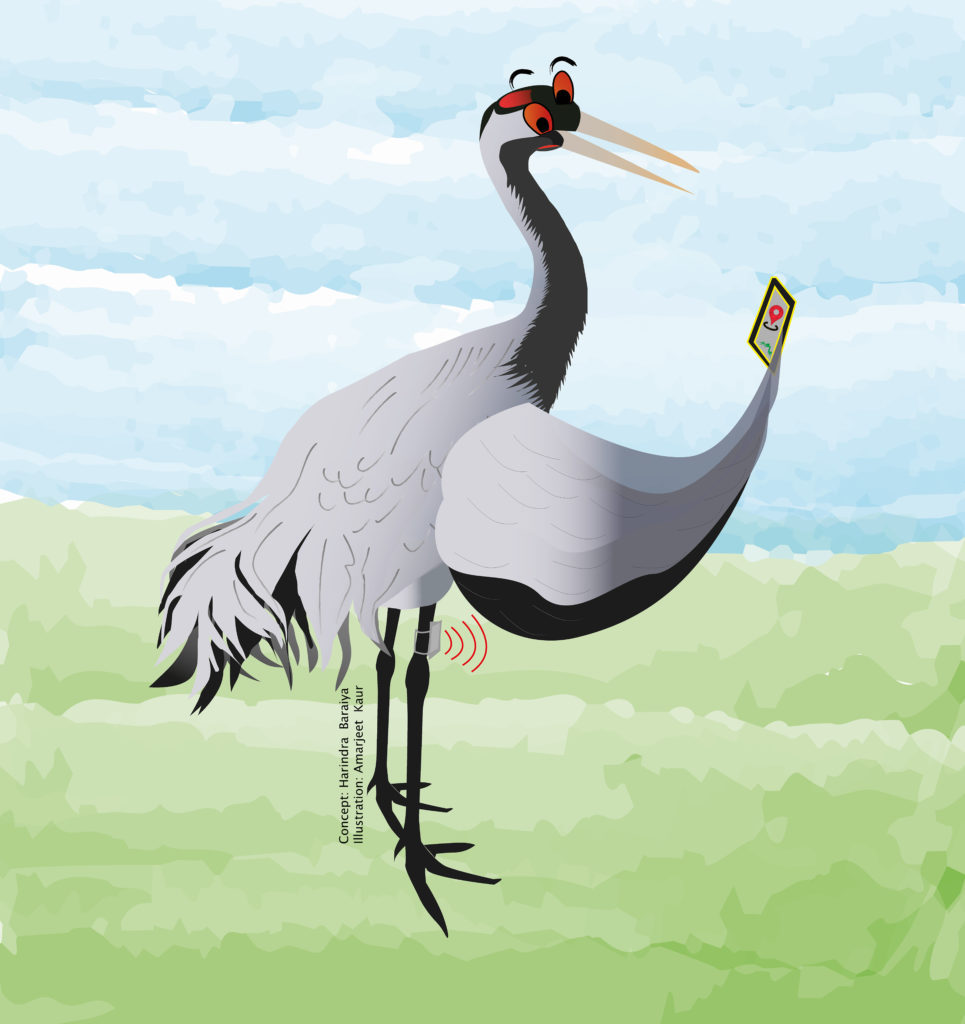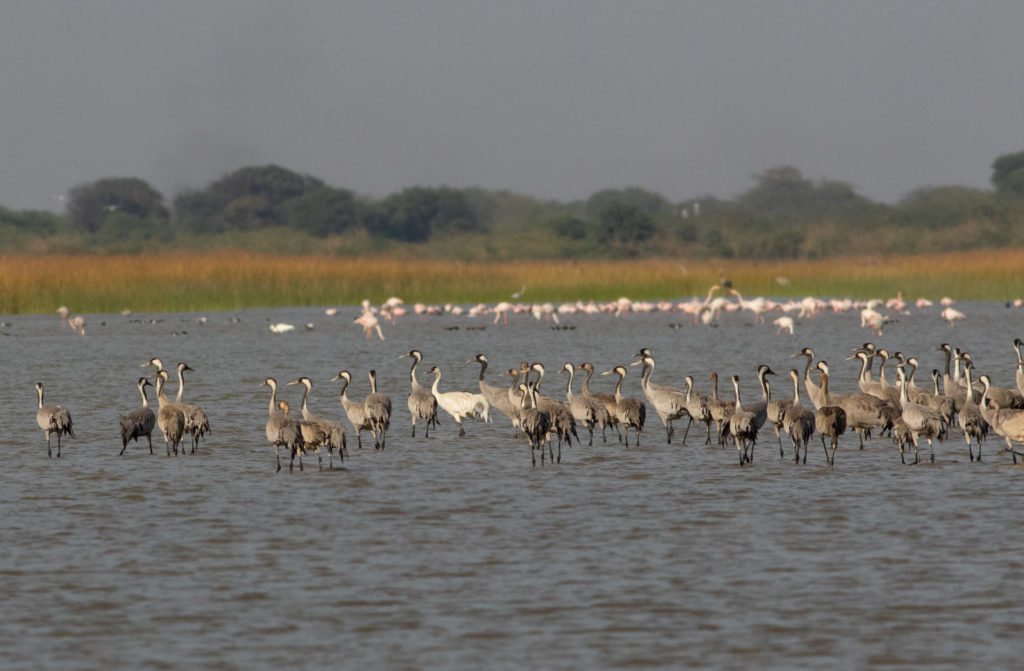It was the second week of March 2020 when my team and I were out in the field at Vadla wetland near Nal Sarovar Ramsar site, Gujarat. We were deploying mist-nets and noose traps to capture and tag Common Cranes with GPS-GSM transmitters. Our efforts to capture cranes started in January 2020, but owing to multiple challenges regarding field conditions and species habits, it was very difficult to capture the cranes in this landscape. We were trying multiple capture methods, and oftentimes, cranes narrowly escaped from our traps. This was also the time when Covid-19 cases were increasing in India and the Government was already considering a nation-wide lockdown. Therefore, it was very crucial to complete tagging as soon as possible, before the lockdown would halt our field activities.
On 12 March, 2020, we decided to attempt capture in a wetland that we had never tried before. We placed a mist-net across the path of crane flight as they approach the marsh for night roosting. Cranes started arriving in the roost, and I was standing by the wetland shore with my binoculars raised, to observe crane shadows in the dark of the dusk. After I saw several flocks flying above or away from the net, eventually, a flock flew almost through the net and the first bird got trapped. Our trapping expert Ganibhai ran into the water and carefully removed the crane from the net. It was a healthy Common Crane, totally fit for tagging. After weeks of effort, we tagged our first crane! It was an amazing experience and learning for me. The learnings during the 2020 winter season helped us in successfully tagging six more cranes during our expedition in 2022, but the first tagging will always remain special for me.
 Correctly deploying a net to capture birds is a crucial step. In this picture, I am spreading the net in the Banni landscape of Kachchh, western Gujarat, India. (Photo credit: Abhishek Kedariya)
Correctly deploying a net to capture birds is a crucial step. In this picture, I am spreading the net in the Banni landscape of Kachchh, western Gujarat, India. (Photo credit: Abhishek Kedariya)
This is how my love for birds and research took shape..
During the first year of my BSc. Zoology at Sir P.P. Institute of Science, Maharaja Krishnakumarsinhji Bhavnagar University, I got a chance to attend a three-day workshop titled “Shape the Youth to Lead the Society for the Protection of Environment”, where I received a book named “Birds of Northern India”. This workshop was organized by Zoology Departement, Sir P.P. Institute of Science and Bird Conservation Society of Gujarat (BCSG), and it introduced me to the beautiful world of wildlife, especially birds, through classroom and field sessions.
I was lucky to be in a city like Bhavnagar where a small forest was present right in the middle of the city. Regular visits to this area nurtured my passion for wildlife and I slowly started observing bird behavior, calls and other wildlife around me. Also, my farm was surrounded by hillocks and thorny semi-arid scrubland and a small irrigation tank. This area is home to rich biodiversity with as many as 110 bird species in such a small area. During the graduation years, I regularly visited the area and recorded my observations by taking field notes and drawing rough sketches of birds which I could not identify.
Regular visits and field notes from the surroundings of my farmland led me to publish my first conference paper on the avian diversity of Bhavnagar in a conference titled “Recent Trends in Science and Technology” organised by SSR College of Arts, Commerce and Science, Silvassa. I enjoyed the field visits and it felt satisfying to have contributed to the expansion of human knowledge about bird diversity of a lesser known area. Also, interactions with other researchers about their research experiences motivated me to get into a research career.
Since my graduation days, I had started thinking about scientific understanding of wildlife and conservation needs. In order to pursue a career in ornithology, I joined a masters program in Zoology with specialization in Avian Biology and Wildlife Biology at the Department of Zoology, at the Maharaja Sayajirao University of Baroda. The general discussions on wildlife conservation circled around endangered species. However, the quote “The time to protect a species is while it is still common” by Rosalie Edge, a renowned environmental advocate, was whirling around in my mind. Therefore, I decided to do my masters dissertation on a common bird species, the Baya Weaver. With the encouragement and guidance of my mentor Dr. Geeta Padate, I carried out a small research project on how much the Baya Weavers prefer to travel, to collect nesting material and food for the hatchlings.
I relished the entire process of developing the methodology, collecting data on the field, data analysis and thesis writing. The feedback for this work from my peers and seniors inspired me to take up science as a career.
 This particular male Baya Weaver was my favourite among all the weaver individuals I observed to collect data for my MSc thesis. This male almost never went to collect nest material but instead, it built its nest with stolen grass fibres from neighbouring weaver nests. (Photo credit: Harindra Baraiya)
This particular male Baya Weaver was my favourite among all the weaver individuals I observed to collect data for my MSc thesis. This male almost never went to collect nest material but instead, it built its nest with stolen grass fibres from neighbouring weaver nests. (Photo credit: Harindra Baraiya)
Having limited research experience, I started looking for opportunities in research institutes in India. After facing several rejections mainly because of my insufficient field experience, I finally got an internship opportunity in the Wildlife Institute of India. As part of this internship, I carried out surveys in the eastern Terai landscape to study distribution and nesting status of four species of weaver birds with a special focus on the globally threatened Finn’s Weaver. Also, during this time I learned bird trapping and ringing under the guidance of Dr. R. Suresh Kumar.
After the internship, I got involved in a bigger project that focused on assessing the impacts of power-lines on large avian species in the arid plains of western Gujarat. This project gave me an opportunity to work in the Kachchh landscape that possesses a unique landscape mosaic and avian diversity. I spent two years doing field work across the landscape and collected data on flamingos, cranes and migratory raptors. One of the crucial aspects of this project was to study the movement patterns of flamingos and cranes to identify powerline corridors that could pose potential risks to birds. For this, I, with the help of my team, fitted six flamingos and one Common Crane with GPS-GSM transmitters to record their fine-scale movements. During the course of this project, I was thoroughly guided and encouraged by Dr. R. Suresh Kumar and Dr. Anju Baroth, which helped me improve my research as well as interpersonal skills.
These tagging and field studies revealed interesting aspects of flamingo and crane ecology in the arid landscape of Gujarat. We got interesting insights in the differential habitat use by flamingos during breeding and non-breeding seasons, their movement habits, movement corridors etc. The tracking of Common Crane revealed very regular movements of the species between roosting and foraging grounds. The migration journey of the tagged Common Crane was even more exciting where we obtained fine scale information on diurnal migration movements, regular night stop-overs, flight heights and flight speed. During this time, I also realized that there is a major knowledge gap in our understanding of the ecology of migratory birds including cranes. This further strengthened my decision to pursue science as a career, starting with a PhD on two long distance migrants to India, the Common and the Demoiselle Crane.
Currently, I am pursuing a PhD under the guidance of Dr. R. Suresh Kumar at the Wildlife Institute of India, Dehradun. I am investigating the factors that influence spatial use by wintering cranes in a multi-use arid landscape of Gujarat. My field sites are in the unique saline meadows of Banni landscape, Kachchh, in agricultural landscape around Nal Sarovar and in Thol Ramsar Sites. Further, I am attempting to understand the migration strategies adopted by cranes across the Central Asian Flyway. Along with on-field studies, I am tracking the movement of cranes using GPS-GSM transmitters to understand how cranes use arid landscapes during winter. Through this, we also aim to understand the migratory paths they take during their journey to and from their breeding grounds in the northern latitudes.
 I believe in communicating science to laymen. Here, with the help of a friend, I have attempted to illustrate how my transmitters work. This is particularly useful to explain my work to local farmers and children.
I believe in communicating science to laymen. Here, with the help of a friend, I have attempted to illustrate how my transmitters work. This is particularly useful to explain my work to local farmers and children.
(Concept: Harindra Baraiya, Illustration: Amarjeet Kaur)
I love what I do because..
I love being out in the field and observing birds, finding patterns in their activities. My day in the field is always exciting and filled with surprises. The winter months of Gujarat are especially beloved to me as I get to observe a number of migratory birds. Everyday, I experience new natural history observations of avian life. I also love the days when I am attempting bird capture for tagging. Tagging birds puts many challenges in front of me and to overcome those challenges, I need to make rapid decisions and use creativity at times. I enjoy the part where I work day and night, in agricultural fields, grasslands and wetlands, setting up traps and in the end, releasing the bird with a state-of-the-art transmitter, anticipating amazing data.
Even more, I enjoy observing the movement tracks received through the transmitter. Google Earth is one of my most favorite applications that enables me to observe the tracks and understand the movement patterns. Trying to understand the sudden changes in bird movement in Google Earth and then in the field is always so exciting as it provides new insights to bird life. My work so far is primarily on commonly found avian species and it gives me immense satisfaction of adding knowledge in the ecology of common species. Such information can aid in understanding the existing and potential future risks to these species.
 An example of how exciting a day can be in the field. In February 2020, we saw a leucistic Common Crane in the Banni landscape in western Gujarat. It was the first such photographic record in Asia.
An example of how exciting a day can be in the field. In February 2020, we saw a leucistic Common Crane in the Banni landscape in western Gujarat. It was the first such photographic record in Asia.
(Photo credit: Rajdeep Mitra)
Challenges I faced..
The first and foremost challenge in wildlife research is the lack of motivation and encouragement at school and college level. The society where I belong believes in 9 to 5 indoor jobs which pay handsomely. Therefore, it took me some time to get my family on board with this kind of career. However, once I explained to them the importance and potential of wildlife research, they supported me in every possible way.
My research involved the capture of large birds and fitting them with GPS-GSM transmitters. Cranes and flamingos can be spotted in many inland wetlands, sometimes in proximity to villages. In these wetlands, capturing birds may offend local people as they are religiously very sensitive towards wildlife. Therefore, before carrying out capture activities, I met with the local leaders, gathered people, and made them aware of the threats to wildlife and how my research activities could help save them. These awareness activities were very effective in getting locals on board for this work and eventually many people helped me.
My advice for young researchers is..
Loving bird watching is not enough reason to pursue a career in Ornithology. Research on birds, and wildlife in general, requires a lot of planning, patience and perseverance. It becomes even more difficult in terms of funding when you are not working on charismatic species. A research study requires proper planning, systematic data collection and analytical and presentation skills. Also, networking with the right people is an integral part of research and therefore, communication skills and cooperation with local communities are much needed. It could be thus helpful to work on research projects as a researcher before committing to a PhD.
Harindra Baraiya
[email protected]
PhD Scholar
Wildlife Institute of India, Dehradun
LinkedIn profile
ResearchGate profile


Congratulations! Your journey motivates me as well to pursue my research and do my bit for wildlife conservation.